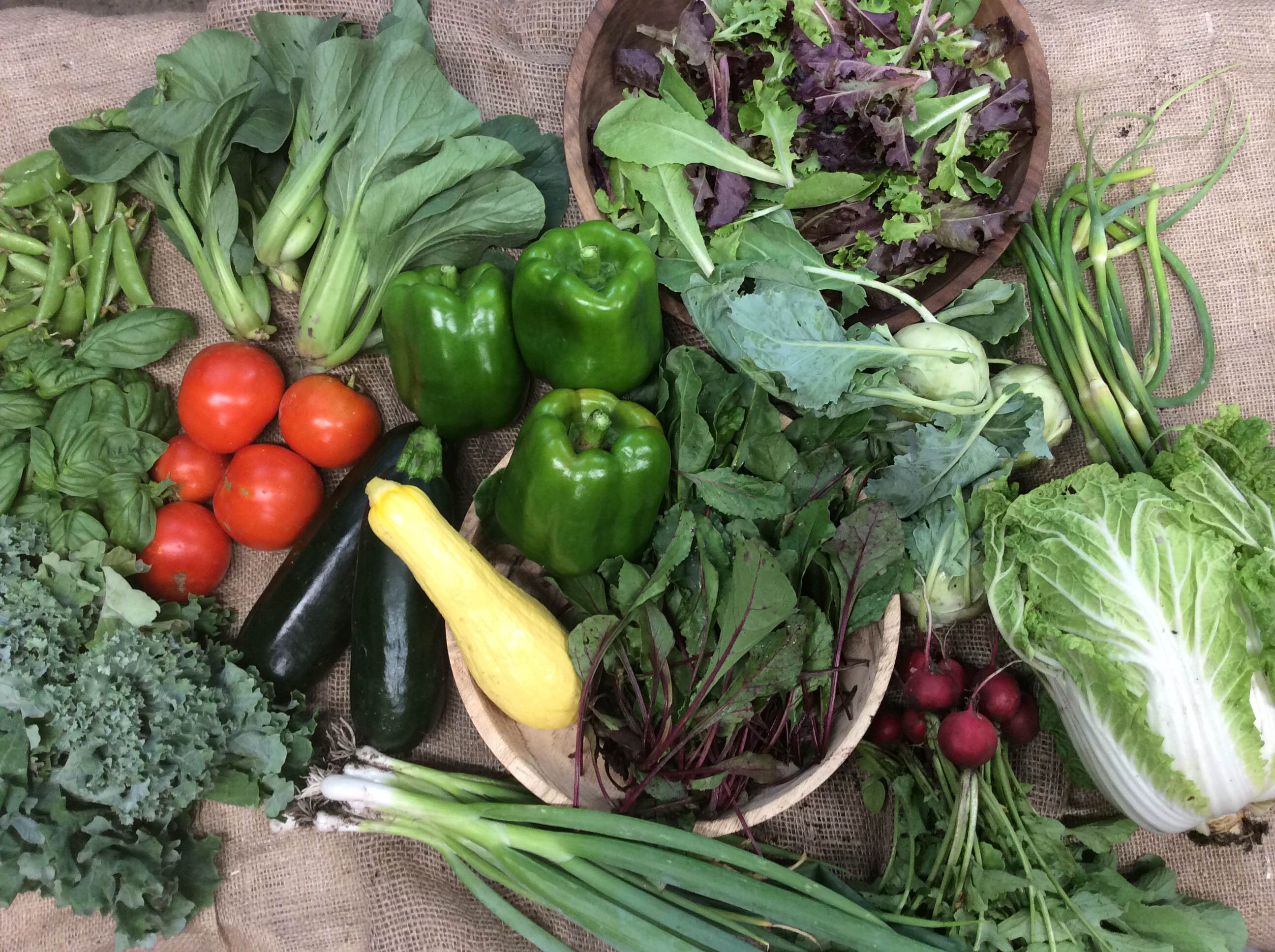Not yet a member? You can still sign up and learn more here!
More variety is added to the 2016 Redfearn Farm CSA Season! We are switching things up a little this week by only having 2 farm selected items, and having an additional choice item for all shares (therefore Basic Shares will get 3 choice items and Premium Shares will get 6 items this week!) The items available for Week 5 of the CSA season are: Farm Selected Items (shown on the top left of the photo):Sugar Snap Peas and Baby Bok Choy and for the Choice Items (roughly top to bottom, L to R): Spring Salad mix, Basil, Tomatoes, Kale, Zucchini/ Yellow squash, Green Bell Peppers, Baby Beet Greens, Green Onions (on the bottom), Kohlrabi, Radishes, Napa Cabbage, Garlic Scapes and Stir-fry greens (not pictured).
Sugar Snap Peas (Farm selected Item): Store in plastic bag in the refrigerator. Peel off the strings on the sugar snap peas before eating or cooking. Sugar snap peas are great raw or barely cooked. Try Stir-fried Sugar Snap Peas or Sugar Snap Peas with orange-ginger dressing.
Baby Bok Choy (Farm selected Item):Store in plastic bag in the refrigerator. Here is a basic bok choy recipe with great instructions: Stir-fried Bok Choy . Cooked (leftover) Bok Choy can be added to fried rice. Bok Choy can also be cooked and used inside egg rolls (I just followed the instructions on the back of the package of egg roll wrappers). Bok Choy can also be grilled, as in this Grilled Baby Bok Choy with Miso butter! Bok choy can be sliced and added to soups during the last few minutes of cooking.If you would rather eat bok choy raw; it can be chopped and dressed with an asian- style dressing: Bok Choy Salad
CHOICES (this time, Basic shares can choose 3, Premium Shares can choose 6!):
Salad mix (Choice Item): Store in plastic bag in the refrigerator. Wash before eating, and dry well. For salad inspiration, look at this: Mesclun Salad with goat cheese, or Chart of Salad Toppings Combinations.
Basil (Choice Item): To keep basil fresh, trim the stems and place them in a glass or jar of water, just like cut flowers. Loosely cover it with a plastic bag and leave it on the counter. Do not refrigerate or basil will darken.Here are some ways to use basil: top sliced tomatoes with chopped basil and olive oil, make Pesto, or use to season italian dishes. If you need to preserve basil leaves; it can be pureed with olive oil and frozen (in ice cube trays or small plastic bags. For more detailed instructions for preserving basil, click here. If you need more ideas for how to use basil, check out this link: 34 Basil recipes to carry you through summer.
Tomatoes (Choice Item): store at room temperature.
Kale (Choice Item): store in plastic bag in refrigerator. Kale can be eaten raw as in Kale Salad and in green smoothies or cooked (sautéed in olive oil or coconut oil), Kale Pesto (Pesto can be frozen). Try this Zuppa Tuscana soup (I usually add a can of tomatoes to this soup and sometimes kidney beans).
Radishes (Choice Item): store in plastic bag in refrigerator.
Zucchini/ Yellow squash (Choice Item, 3 zucchini/ squash mix or match, will count as one item): store in plastic bag in refrigerator. Zucchini is great raw or sautéed, grilled, or baked into zucchini bread (my kids favorite way to eat zucchini!). Raw zucchini/ squash makes a fresh, flavorful salad as in this: Summer Squash Salad with Lemon Citronette. Zucchini (sliced and broiled or pan fried) can take the place of pasta in lasagna. If you want more ideas, you can try Baked Zucchini Fries, Squash baked eggs or Zucchini Fritters or Chocolate Zucchini Bread or these main dishes Baked Penne with Roasted Vegetables (this is a great recipe to use a lot of vegetables, including zucchini, yellow squash, eggplant, peppers, onions and garlic), Cheesy Zucchini Casserole (which we make with shredded sharp cheddar, instead of Velvetta). Here’s a couple other zucchini recipes, recommended by CSA members: Curried Zucchini Soup, Zucchini Tots, Sauteed Zucchini with Cherry Tomatoes (don’t overcook the zucchini!), and Zucchini Chocolate Rum Cake. To preserve: Zucchini or Yellow squash can be shredded and frozen to use in Zucchini bread recipes.
Green Bell Peppers (Choice Item, 3 peppers will count as one item): store in plastic bag in refrigerator. Eat raw or cooked, in Philly Cheese Sandwich or Fajitas. Stuffed peppers are also a favorite main dish at our house; zucchini/ yellow squash can also be stuffed using the same recipe. Sweet peppers can easily be preserved by freezing and they can be frozen raw, without blanching first. Cut peppers into the desired size: diced for adding to winter casseroles, soups or sauces; sliced for fajitas; or halved (or the tops cut off) to be used for stuffed peppers (also, after freezing there is no need to parboil peppers before stuffing) and freeze in freezer bags.
Baby Beet greens: Store in plastic bag in the refrigerator. Baby beet greens are great sautéed, here is a link to Sauteed Beet Greens with a great instructional video.
Napa Cabbage (Choice Item): store in plastic bag in refrigerator.
Kohlrabi: Both the leaves and the bulbous stem (the round part) are edible. The bulbous part can last for a couple weeks in the fridge, but the greens should be use within a couple days, both should be stored in plastic bags in the refrigerator . The bulb should be peeled by cutting off a thin slice on the top and bottom of the bulb and using a paring knife to cut the skin off the kohlrabi bulb.Here is a link with recipes using the kohlrabi bulb and greens, including one of our favorites, the kohlrabi patties: Kohlrabi Recipes. A simple preparation of kohlrabi is Butter- braised Kohlrabi: Peel kohlrabi, and thinly slice (1/8 to 1/4 inch thick) and cook in a skillet with butter and olive oil and salt and pepper, add about 1/2 cup of chicken broth, cover the skillet and cook, stirring occasionally, until tender. Optional: Cream can be added at the end. Eaten raw, kohlrabi is fresh, crisp, and the ideal ingredient for a summer slaw, such as this Kohlrabi and Carrot slaw.
Garlic Scapes (Choice Item): Store in plastic bag in the refrigerator. Garlic Scapes are the flower bud of the garlic plant. The bud is removed to encourage the bulbs to thicken up. Scapes taste just like garlic. They can be used the same way as garlic in nearly any recipe. On thicker scapes, snap off the woody end (in the same way you would snap asparagus). Try them in a sauté, roasted, pickled, added to soups, and more. The most tender tops of the stem and the buds are delicious chopped up raw. To preserve: Chop the scapes in a food processor, add to jars and cover with olive oil. Save this in the fridge for up to a year, sometimes add more oil to keep it covered. Use on salads, baste on meats and vegetables for grilling, garlic bread, anything your imagination can think of. You can also freeze cubes of this in a ice cube tray then put in a zip lock bag and keep frozen.
A site highlighting many ways to serve garlic scapes; including a garlic scape pesto recipe: What to do with Garlic Scapes (Note: my family made the Garlic Scape Pesto from this link, using sunflower seeds instead of pine nuts, and it was wonderful (and very garlicky!).
Garlic Scape and White Bean Hummus
1/3 cup sliced scapes
1 T lemon juice
1/2 tsp sea salt
ground black pepper
1 can (15 oz.) cannelloni beans, rinsed and drained
1/4 cup olive oil
In a food processor, process scapes with lemon juice, salt and pepper until finely chopped. Add beans and process to a rough puree. With motor running, slowly drizzle olive oil through feed tube and process until fairly smooth. Pulse in 2 or 3 T water, or more, until mixture is the consistency of a dip.

